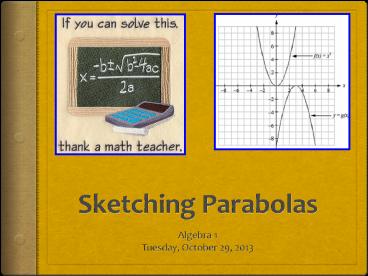Sketching Parabolas - PowerPoint PPT Presentation
1 / 15
Title:
Sketching Parabolas
Description:
Who came up with the Quadratic Formula? 3000 B.C Sumerians divide day into 24 hrs 2400 B.C Papyrus in Egypt 1800 B.C. Babylonians have multiplication table 44 B.C ... – PowerPoint PPT presentation
Number of Views:205
Avg rating:3.0/5.0
Title: Sketching Parabolas
1
Sketching Parabolas
- Algebra 1
- Tuesday, October 29, 2013
2
Who came up with the Quadratic Formula?
900 B.C. First recorded symbol for Zero
1947 A.D Jackie Robinson
2400 B.C Papyrus in Egypt
1 B.C.
3000 B.C Sumerians divide day into 24 hrs
1800 B.C. Babylonians have multiplication table
44 B.C Caeser assassinated
1633 A.D Galileo condemned to death
http//www.au.af.mil/au/awc/awcgate/timeline/time0
002.htm
3
(No Transcript)
4
Who came up with the Quadratic Formula?
900 B.C. First recorded symbol for Zero
1947 A.D Jackie Robinson
2400 B.C Papyrus in Egypt
1 B.C.
3000 B.C Sumerians divide day into 24 hrs
1800 B.C. Babylonians have multiplication table
44 B.C Julius Caeser assassinated
1633 A.D Galileo condemned to death
http//www.au.af.mil/au/awc/awcgate/timeline/time0
002.htm
5
Discriminant- the value inside the radical (
) when you do the quadratic formula.
This value can be positive, zero, or negative.
Roots of a Polynomial- the answer(s) for x.
Where the graph of the parabola intersects the
x-axis. There can be two roots, one root, or No
roots.
6
Two Roots
Positive
7
One Root
Zero
8
No Roots
Negative
9
Discriminant- the value inside the radical (
) when you do the quadratic formula.
This value can be positive, zero, or negative.
Roots of a Polynomial- the answer(s) for x.
Where the graph of the parabola intersects the
x-axis. There can be two roots, one root, or No
roots.
- Parabola- the type of curve you get when you
neatly graph a quadratic equation. - Positive, or upward, parabolas have a minimum
point.
10
When the a in, ax2, is Positive
Upward
Happy
Minimum
11
Discriminant- the value inside the radical (
) when you do the quadratic formula.
This value can be positive, zero, or negative.
Roots of a Polynomial- the answer(s) for x.
Where the graph of the parabola intersects the
x-axis. There can be two roots, one root, or No
roots.
- Parabola- the type of curve you get when you
neatly graph a quadratic equation. - Positive, or upward, parabolas have a minimum
point. - Negative, or downward, parabolas have a maximum
point.
12
When the a in, ax2, is Negative
Maximum
Downward
Sad
13
Discriminant- the value inside the radical (
) when you do the quadratic formula.
This value can be positive, zero, or negative.
Roots of a Polynomial- the answer(s) for x.
Where the graph of the parabola intersects the
x-axis. There can be two roots, one root, or No
roots.
- Parabola- the type of curve you get when you
neatly graph a quadratic equation. - Positive, or upward, parabolas have a minimum
point. - Negative, or downward, parabolas have a maximum
point. - Parabolas are symmetrical along their vertical
line of symmetry which is always halfway
between points of equal height.
14
Symmetry
- - - - - - - - - - - - - - - -
- - - - - - - - - - - - - - - -
15
Discriminant (b2-4ac) Number of Roots (Number of answers) Sketch of Sample Graph
16
Deriving the Quadratic Formula































